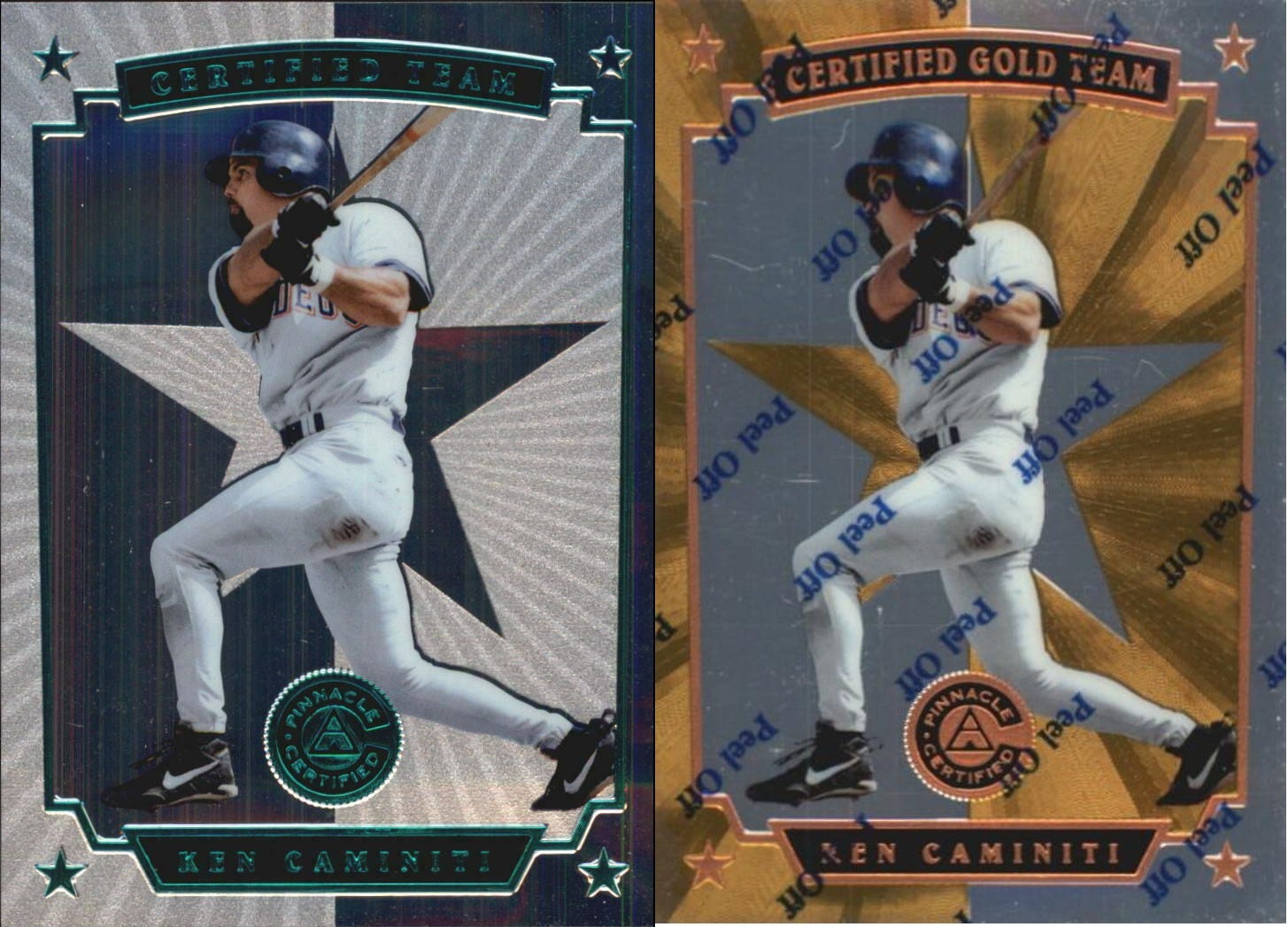Some cool Ken Caminiti cards, Pt. 6: Pinnacle Certified edition
Here's a look at a few cards in my collection that stand out to me.
Ken Caminiti's baseball career coincided with lots of developments in the baseball card world.
His early major league days came during the so-called "junk wax era" because cards of the late 1980s and early 1990s were generally mass produced (and typically not very valuable).
Out of the age of stale gum and overprinted cardboard came developments that are still in use today: higher-end releases, serial-numbered inserts, flashy, shiny, chromium card stock, and autographs and game-used items featured on cards.
Here's a look at a few 1997 and 1998 Pinnacle Certified cards of Ken's in my collection that stand out to me (also check out Pt. 1, Pt. 2, Pt. 3, Pt. 4 and Pt. 5).
1997 Pinnacle Totally Certified Platinum Gold
Certified represented Pinnacle's answer to Topps’ popular Finest and Chrome brands. It even came with a peel-off sleeve.
Ken Caminiti inexplicably was not included in (Select) Certified’s 1995 or 1996 releases. The 1996 product was widely acclaimed for its low print runs for parallels, and cards of stars like Derek Jeter and Ken Griffey Jr. can still sell for thousands of dollars today.
1997 Pinnacle Certified used a similar rainbow of parallels, but without the scarcity. Parallels included Certified Red, Mirror Red, Mirror Blue and Mirror Gold; some cards also had Mirror Black parallels. None of the base card parallels were all that rare (more on insert parallels below).

Pinnacle subsequently released Totally Certified, a premium parallel brand that featured a nearly identical checklist and similarly-designed cards that had lots of etching. Totally Certified cards are all serial numbered and come in only three colors: Platinum Red (numbered to 3,999), Platinum Blue (numbered to 1,999) and Platinum Gold, which were numbered to 30 copies.

Ken’s Pinnacle Certified cards show him swinging, while his Totally Certified cards show him following through.
The biggest confusion involves the gold parallels. Here's what a Certified Mirror Gold card, left, looks like next to a Totally Certified Platinum Gold card:
The Platinum Gold card I have here is not numbered on the back, meaning it was back-doored. Obviously I'd prefer a version numbered to 30, but given how rare they are, I didn't want to pass up the unnumbered one.
If you decide you want to buy any 1997 Certified or Totally Certified cards, especially the gold ones, do your research! Far too often a Certified Mirror Gold will be labeled on eBay as being 1/30, when it's not. Still a pretty card! Just worth knowing what you are buying (and it could end up saving you hundreds of dollars).
1997 Pinnacle Certified Team
Now back to those inserts that were included in packs of 1997 Pinnacle Certified.
Ken was featured in a Certified Team insert set, and these cards did offer a low-numbered parallel. The base inserts were inserted every 19 packs, on average, while a gold parallel version was serial numbered to 475.
Mirror Gold Certified Team, meanwhile, was numbered to only 25 copies. I can't say that I've ever seen a Mirror Gold Certified Team card of Ken's, but here's what a similar card of John Smoltz looks like compared to the Gold Team parallel.
1998 Pinnacle Certified Mirror Red Test Issue
1998 Pinnacle Certified could have been a fun set. But Pinnacle Brands went under before the product could be released.
Thankfully, a number of the cards -- including Ken's -- have emerged on the secondary market, evidently a parting gift for some of Pinnacle's last employees. I was able to pick up a Mirror Red version for about $100, and that seems to be the asking price of his 1998 Certified cards.
Ken's base, Certified Red, Mirror Gold and Mirror Blue cards have appeared online in the past few years.
As with backdoored cards, there's no clear understanding of how many of the cards exist. They could sit in private collections forever or pop up online tomorrow, and the market will be whatever collectors are willing to pay for them. But the amount of time that's passed without the market being flooded, I believe, speaks to the relative scarcity of the cards.





